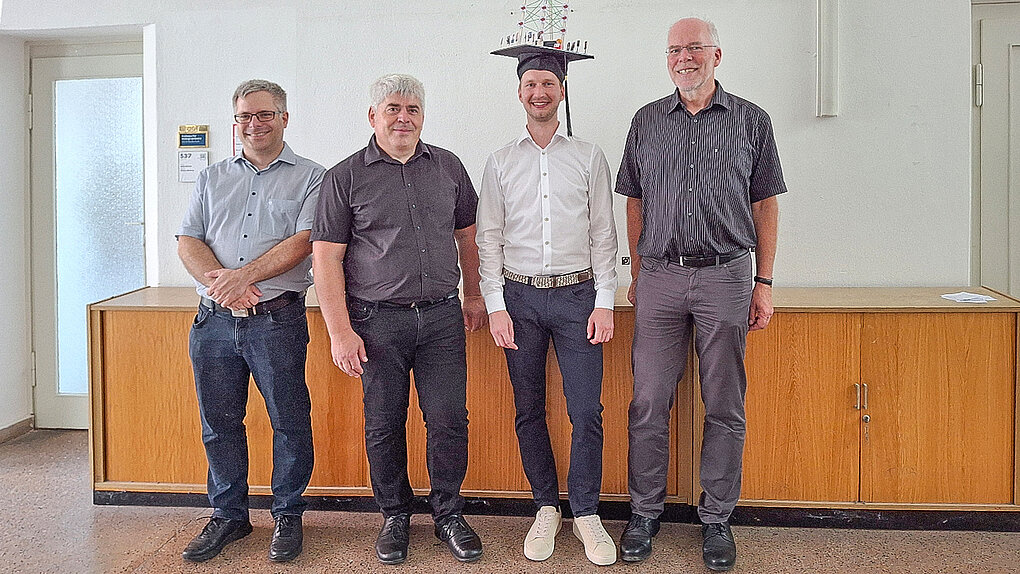On 12.07.2024, Franz Wagner, M.Sc. successfully defended his scientific thesis as part of the doctoral procedure with the topic "Segmentation in Tomography Data: Exploring Data Augmentation for Supervised and Unsupervised Voxel Classification with Neural Networks". In addition to the chair of the doctoral committee, JProf. Dr. Anette Eltner, (Technische Universität Dresden), the reviewers were Prof. Dr. sc. techn. habil. Hans-Gerd Maas (Technische Universität Dresden), apl. Prof. Dr. techn. Franz Rottensteiner (Leibniz University Hannover) and Dr.-Ing. habil. Martin Weinmann (Karlsruhe Institute of Technology) were present.
Abstract:
Computed Tomography (CT) imaging provides invaluable insight into internal structures of objects and organisms, which is critical for applications ranging from materials science to medical diagnostics. In CT data, an object is represented by a 3D reconstruction that is generated by combining multiple 2D X-ray images taken from various angles around the object. Each voxel, a volumetric pixel, within the reconstructed volume represents a small cubic element, allowing for detailed spatial representation. To extract meaningful information from CT imaging data and facilitate analysis and interpretation, accurate segmentation of internal structures is essential. However, this can be challenging due to various artifacts introduced by the physics of a CT scan and the properties of the object being imaged.
This dissertation directly addresses this challenge by using deep learning techniques. Specifically, Convolutional Neural Networks (CNNs) are used for segmentation. However, they face the problem of limited training data. Data scarcity is addressed by data augmentation through the unsupervised generation of synthetic training data and the use of 2D and 3D data augmentation methods. A combination of these augmentation strategies allows for streamlining segmentation in voxel data and effectively addresses data scarcity. Essentially, the work aims to simplify training of CNNs, using minimal or no labeled data. To enhance accessibility to the results of this thesis, two user-friendly software solutions, unpAIred and AiSeg, have been developed. These platforms enable the generation of training data, data augmentation, as well as training, analysis, and application of CNNs.
This cumulative work first examines simpler but efficient conventional data augmentation methods, such as radiometric and geometric image manipulations, which are already widely used in literature. However, these methods are usually randomly applied and do not follow a specific order. The primary focus of the first paper is to investigate this approach and to develop both online and offline data augmentation pipelines that allow for systematic sequencing of these operations. Offline augmentation involves augmenting training data stored on a drive, while online augmentation is performed dynamically at runtime, just before images are fed to the CNN. It is successfully shown that random data augmentation methods are inferior to the new pipelines.
A careful comparison of 3D CNNs is then performed to identify optimal models for specific segmentation tasks, such as carbon and pore segmentation in CT scans of Carbon Reinforced Concrete (CRC). Through an evaluation of eight 3D CNN models on six datasets, tailored recommendations are provided for selecting the most effective model based on dataset characteristics. The analysis highlights the consistent performance of the 3D U-Net, one of the CNNs, and its residual variant, which excel at roving (a bundle of carbon fibers) and pore segmentation tasks.
Based on the augmentation pipelines and the results of the 3D CNN comparison, the pipelines are extended to 3D, specifically targeting the segmentation of carbon in CT scans of CRC. A comparative analysis of different 3D augmentation strategies, including both offline and online augmentation variants, provides insight into their effectiveness. While offline augmentation results in fewer artifacts, it can only segment rovings already present in the training data, while online augmentation is essential for effectively segmenting different types of rovings contained in CT scans. However, constraints such as limited diversity of the dataset and overly aggressive augmentation that resulted in segmentation artifacts require further investigation to address data scarcity.
Recognizing the need for a larger and more diverse dataset, this thesis extends the results of the three former papers by introducing a deep learning-based augmentation using a Generative Adversarial Network (GAN), called Contrastive Unpaired Translation (CUT), for synthetic training data generation. By combining the GAN with augmentation pipelines, semi-supervised and unsupervised end-to-end training methods are introduced and the successful generation of training data for 2D pore segmentation is demonstrated. However, challenges remain in achieving a stable 3D CUT implementation, which warrants further research and development efforts.
In summary, the results of this dissertation address the challenges of accurate CT data segmentation in materials science through deep learning techniques and novel 2D and 3D online and offline augmentation pipelines. By evaluating different 3D CNN models, tailored recommendations for specific segmentation tasks are provided. Furthermore, the exploration of deep learning-based augmentation using CUT shows promising results in the generating synthetic training data.
Future work will include the development of a stable implementation of a 3D CUT version, the exploration of new model architectures, and the development of sub-voxel accurate segmentation techniques. These have the potential for significant advances in segmentation in tomography data.
We would like to congratulate Mr. Franz Wagner on completing his doctorate and wish him all the best and every success for the future.





